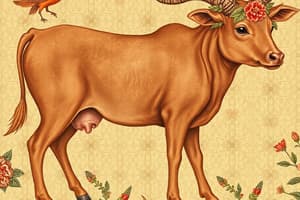Podcast
Questions and Answers
What is the role of enzymes in chemical digestion?
What is the role of enzymes in chemical digestion?
Enzymes break down large organic molecules into simpler compounds.
Explain the difference between active transport and passive diffusion in nutrient absorption.
Explain the difference between active transport and passive diffusion in nutrient absorption.
Active transport requires energy to move nutrients against a concentration gradient, while passive diffusion moves nutrients based on concentration gradients without needing energy input.
How do fat-soluble vitamins differ in terms of absorption compared to other nutrients?
How do fat-soluble vitamins differ in terms of absorption compared to other nutrients?
Fat-soluble vitamins require additional processes involving dietary lipid carriers to assist in absorption through mucosal layers.
What are microvilli, and how do they contribute to nutrient absorption?
What are microvilli, and how do they contribute to nutrient absorption?
Why is understanding nutrient absorption important in the context of animal health and conservation?
Why is understanding nutrient absorption important in the context of animal health and conservation?
Flashcards are hidden until you start studying
Study Notes
Nutrition in Animals: Understanding Nutrient Absorption
As we delve into the world of animal nutrition, one crucial aspect deserves close attention—the process by which organisms extract vital nutrients from their diets. This ability, known as nutrient absorption, ensures animals obtain essential elements like amino acids, vitamins, minerals, and fats to sustain life, growth, and reproduction. Let's explore this fascinating biological phenomenon and its importance within the realm of animal nutrition.
Nutrient absorption is primarily facilitated through two primary structures: the gastrointestinal tract (GI tract) and specialized cells called enterocytes lining the digestive system. As food travels along the GI tract, several physiological processes work together to break down complex molecules into smaller components more easily absorbed by our furry friends.
Mechanical Processes
Before nutrients can be absorbed, they must first undergo mechanical breakdown via physical forces such as grinding, mixing, and churning during digestion. Chewing and swallowing initiate these actions early in the esophagus; later stages involve propulsion of ingested materials throughout the stomach and intestines due to contractions and peristaltic movements.
Chemical Digestion
Chemical digestion refers to enzymatic reactions breaking bonds between atoms within large organic molecules (e.g., proteins, carbohydrates, lipids), converting them into simpler compounds that cross the cell membranes of enterocytes. Secretions released by various accessory organs, including salivary glands, pancreas, bile duct, and liver, aid this process. Enzymes present in these secretions act upon specific substrates to produce water-soluble nutrients amenable to subsequent absorption across the epithelial barriers.
Once broken down into simpler forms, nutrients become available for active transport across the microvilli, finger-like projections covering the lumenal face of each enterocyte. These structures increase surface area dramatically, enhancing opportunities for nutrient uptake.
Active Transport and Passive Diffusion
The majority of nutrients rely on either active transport mechanisms or passive diffusion to traverse the enterocyte membrane. In active transport, carrier proteins facilitate movement against a concentration gradient, requiring energy expenditure either directly from ATP hydrolysis or indirectly via coupled reactions in exchange for other ions. Examples of nutrients entering the enterocytes via active transporters include sugars (glucose, galactose, etc.), certain amino acids, and some mineral ions (calcium).
Passive diffusion occurs when nutrients move unassisted across cellular membranes according to their respective concentrations gradients without any additional energy input requirements. Fatty acids and nonessential amino acids typically passively diffuse across enterocyte membranes.
Vitamin Deficiency and Supplementation
Some nutrients exhibit unique characteristics preventing direct absorption despite following typical pathways used for most cofactors and macronutrients. For example, fat-soluble vitamins require additional processes whereby dietary lipid carriers help carry these nutrients through the mucosal layers before being taken up by enterocytes. Some species may possess reduced capacities to absorb particular nutrients, leading to deficiencies if specific supplementation isn't considered.
Understanding nutrient absorption in animals offers significant insights into macro level concepts ranging from optimal feeding strategies and design principles underlying modern livestock production systems to potential implications regarding wildlife conservation efforts. Investigating how different species utilize varying types of diets and resource availability provides valuable knowledge concerning appropriate management techniques aimed at maintaining healthy populations while minimizing ecological impacts.
Studying That Suits You
Use AI to generate personalized quizzes and flashcards to suit your learning preferences.




